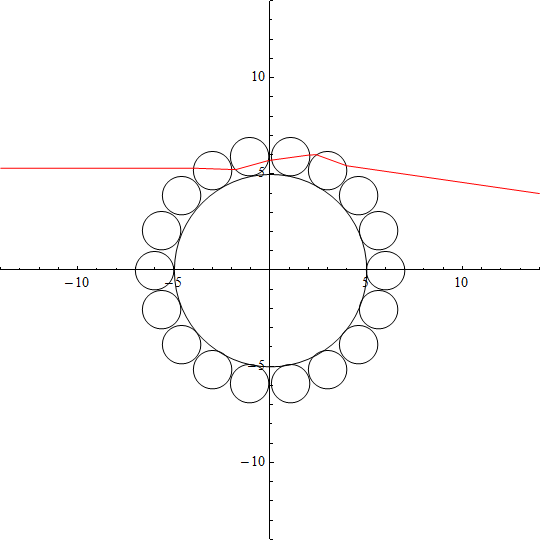Hello, yes I have fixed it!
If you want to change the parameters n2 is the refractive index of the lens material and the initial ray height can be set by changing yint[1,1]
What I have left to do is create another loop that will add in more rays.
If you have any feedback/improvements on the code I would love to hear it as this is my first coding project since high school, and first with Mathematica.
Here is what the code will output:

ClearAll["Global`*"]
(*draw circles*)
(*input data*)
LcircRad = 5;
ScircRad = 1;
n1 = 1; (*refractiv index of free space*)
n2 = 1.5; (*ref index of lens*)
(*angle per circle theta*)
theta = 2 ArcSin[ScircRad/(LcircRad + ScircRad)];
(*lenses per circle*)
nlens = Floor[2 \[Pi]/theta];
(*corrected angle per circle to ensure even distriubution*)
theta = N[2 \[Pi]/nlens];
(*populating arrays with x and y centres of small circles
ofset with \[Pi] so that first circle is drawn on the left*)
xcircle =
Table[(LcircRad + ScircRad) Cos[theta i + \[Pi]], {i, 0, nlens, 1}];
ycircle =
Table[(LcircRad + ScircRad) Sin[theta i + \[Pi]], {i, 0, nlens, 1}];
(*calculates number of rays*)
totalD = 2 (LcircRad +
2 ScircRad);(*total diameter of lens structure*)
raystarty = LcircRad + 2 ScircRad;(*starting height of first ray*)
raystartx = -3;(*starting x of rays*)
rayspacing = 1;(*vertical spacing between rays*)
nrays = Floor[totalD/rayspacing];
rayspacing = totalD/nrays;
(*populate the first intersection points & grad for ray plotting*)
(*
Do[yint[i,1]=raystarty-rayspacing(i-1),{i,1,nrays+1,1}]
Do[xint[i,1]=0,{i,1,nrays+1,1}]
Do[raygrad[i,1]=0,{i,1,nrays+1,1}]
*)
xint[1, 1] = -totalD;
yint[1, 1] = 5.3;
raygrad[1, 1] = 0;
j = 2;
xintemp = {1};
While[xintemp != {},
y = raygrad [1, j - 1] (x - xint[1, j - 1]) +
yint[1, j -
1];(*y=m(x-x1)+y1 point grad form of straight line for ray at \
prev int point*)
(*temp stores x int of line and circles and ingnores the solution \
which is the prev intersection using cases, rounded so that cases can \
remove the right thing*)
xintemp =
Select[
Cases[
Round[
Flatten[Table[
Select[
NSolve[(x - xcircle[[i]])^2 + (y - ycircle[[i]])^2 ==
ScircRad^2, x, WorkingPrecision -> 3][[All, 1, 2]],
Element[#, Reals] &],
{i, 1, nlens} ]],
0.00001],
Except[xint[1, j - 1]]]
, # > xint[1, j - 1] &];
(*solves the line for y using x intercepts*)
yintemp = Round[
Flatten[Table[
Solve[
ysol == raygrad [1, j - 1] (xintemp[[i]] - xint[1, j - 1]) +
yint[1, j - 1], ysol][[All, 1, 2]],
{i, Dimensions[xintemp][[1]]}]]
, 0.00001];
(*find coord of new intersection closest to prev*)
xint[1, j] =
Nearest[Table[{xintemp[[i]], yintemp[[i]]}, {i,
Dimensions[xintemp][[1]]}], {xint[1, j - 1],
yint[1, j - 1]}][[1, 1]];
yint[1, j] =
Nearest[Table[{xintemp[[i]], yintemp[[i]]}, {i,
Dimensions[xintemp][[1]]}], {xint[1, j - 1],
yint[1, j - 1]}][[1, 2]];
(*finds the circle number of the given intersection point*)
circno = Position[
Round[
Table[
Select[
NSolve[(x - xcircle[[i]])^2 + (y - ycircle[[i]])^2 ==
ScircRad^2, x][[All, 1, 2]],
Element[#, Reals] &],
{i, 1, nlens, 1} ],
0.00001],
xint[1, j]][[1, 1]];
(*finds tangent and norm grad at point of intersection bw ray and \
circle*)
normgrad = (ycircle[[circno]] - yint[1, j])/(
xcircle[[circno]] - xint[1, j]);
normang = ArcTan[normgrad];
alpha1 =
ArcTan[Abs[(raygrad [1, j - 1] - normgrad)/(
1 + raygrad [1, j - 1]*normgrad)]];
alpha2 = ArcSin[(n1/n2) Sin[alpha1]];
If[normang > 0, raygrad[1, j] = Tan[normang - alpha2],
raygrad[1, j] = Tan[normang + alpha2]];
j = j + 1;]
(*
,{j,20}]
*)
(*after while loop is exited need to find intersection with ending \
line*)
y =.;
j = j - 1;
xint[1, j] = totalD;
yint[1, j] =
raygrad [1, j - 1] (xint[1, j] - xint[1, j - 1]) +
yint[1, j - 1];
matrixer[functionName_Symbol] :=
Normal[SparseArray[ReleaseHold[DownValues[#] /. # -> List]]] &[
functionName]
(*turns xint and yint to matrix & removes the tailing entry which is \
bad cos of bad while loop
xintmatrix=matrixer[xint];
xintmatrix=Delete[xintmatrix,{1,Dimensions[xintmatrix][[2]]}];
yintmatrix=matrixer[yint];
yintmatrix=Delete[yintmatrix,{1,Dimensions[yintmatrix][[2]]}];*)
xintmatrix = matrixer[xint];
yintmatrix = matrixer[yint];
Show[Table[
Graphics[Circle[{xcircle[[i]], ycircle[[i]]}, ScircRad]], {i, 1,
nlens, 1}], Graphics[Circle[{0, 0}, LcircRad]],
Table[
Graphics[{Red,
Line[{{xintmatrix[[1, o]],
yintmatrix[[1, o]]}, {xintmatrix[[1, o + 1]],
yintmatrix[[1, o + 1]]}}]}]
, {o, Dimensions[xintmatrix][[2]] - 1}],
PlotRange -> {{-1 totalD, 1 totalD}, {-1 totalD, 1 totalD}},
Axes -> True]